Welcome to the captivating world of avian wildlife, where birds that start with the letter P steal the spotlight. From the elegant Peacock with its resplendent feathers to the agile Peregrine Falcon, these avian wonders have captured the hearts and imaginations of bird enthusiasts worldwide. The vibrant Purple-crested Turaco and the charismatic Puffin also make their appearance in this diverse lineup. With their unique characteristics, stunning plumage, and intriguing behaviors, these birds showcase the extraordinary diversity found in the natural world. Join us as we embark on a thrilling journey, uncovering the secrets of these feathered creatures and exploring their habitats across the globe. Get ready to be amazed by the P-branded stars of the avian kingdom as we delve into their captivating stories.
Species of Birds that Starts With P
Pied Avocet:
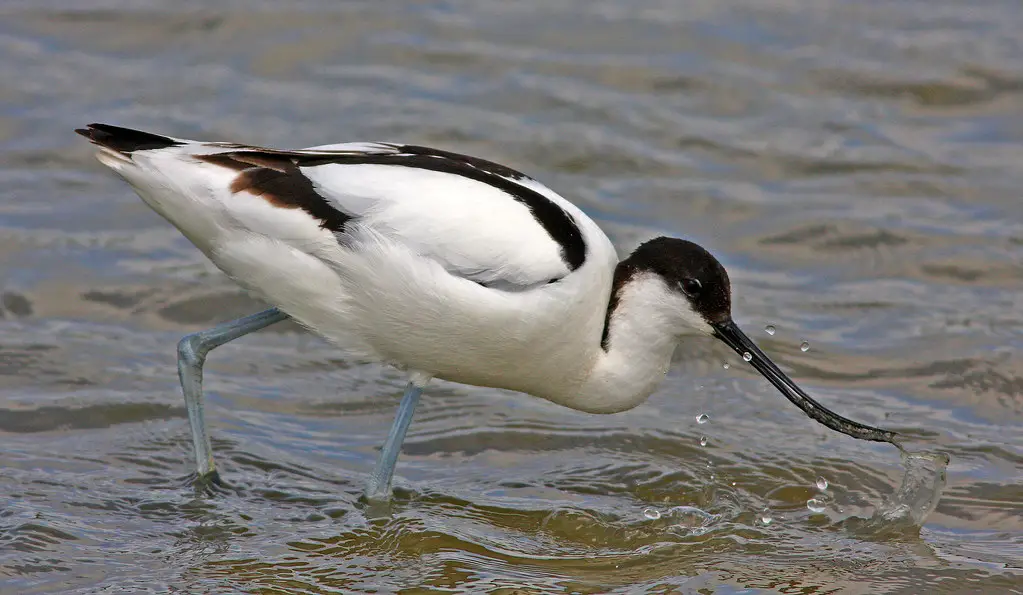
Image Source
- Scientific name: Recurvirostra avosetta
- Lifespan: Up to 20 years
- Size: 42-47 centimeters (17-19 inches)
- Weight: 250-400 grams (8.8-14.1 ounces)
- Origin: Europe, Asia, and Africa
The Pied Avocet (Recurvirostra avosetta) is a distinctive wading bird with black and white plumage and long, thin legs. It is known for its upturned black bill, which it uses to sweep through shallow water in search of aquatic invertebrates. Found in parts of Europe, Asia, and Africa, the Pied Avocet prefers coastal saltmarshes, lagoons, and shallow wetlands as its habitat. It forms large breeding colonies and performs elaborate courtship displays. With its elegant appearance and graceful movements, the Pied Avocet is a captivating sight in its natural environment.
Pine Grosbeak

Image Source
- Scientific name: Pinicola enucleator
- Life span: Up to 10 years
- Size: 22-24 cm (8.7-9.4 in)
- Weight: 40-80 g
- Origin: Northern North America and Eurasia
The Pine Grosbeak (Pinicola enucleator) is a beautiful songbird found in the northern parts of North America, Europe, and Asia. The male has a striking red plumage, while the female is more subdued with a mix of gray and yellow tones. They inhabit coniferous forests, particularly during the breeding season. The Pine Grosbeak primarily feeds on the seeds of various trees, including pine, spruce, and juniper. During the winter months, they may also consume berries and fruits. With their melodious songs and vibrant colors, Pine Grosbeaks add beauty to the northern forests they call home.
Purple-crested Turaco 
- Scientific name: Tauraco porphyreolophus
- Lifespan: up to 30 years.
- Size: 46 cm
- Native to: Burundi, Kenya, Malawi, Mozambique, Rwanda, South Africa, Eswatini, Tanzania, Uganda, Zambia, and Zimbabwe. Their southernmost occurrence is at the Mtamvuna River on the KwaZulu-Natal-Eastern Cape border
Previously thought to belong to the Musophagidae family, the purple-crested turaco is now included in the Turacos.
Many African nations are home to it, including Burundi, Kenya, Malawi, Rwanda, Mozambique, and South Africa. This bird is known as the purple-crested lourie in South Africa.
This particular bird species is mostly a frugivore and is well-recognized for bringing seeds back to its nest. It has a purple crest and body, a green head, and brown and green markings on the chest and neck.
Pyrrhuloxia

Image Source
- Scientific name: Cardinalis sinuatus
- Life span: Up to 10 years
- Size: 20-23 cm (7.9-9.1 in)
- Weight: 42-50 g
- Origin: Southwestern United States and Mexico
The Pyrrhuloxia (Cardinalis sinuatus) is a unique bird species closely related to the Northern Cardinal. It is found in the southwestern United States and northern Mexico. The male Pyrrhuloxia displays a distinctive combination of gray, red, and rusty plumage, while the female has a more muted appearance with brown and gray tones. They inhabit desert scrublands, mesquite thickets, and arid regions. The Pyrrhuloxia primarily feeds on seeds, fruits, and insects. Known for its distinctive calls, the Pyrrhuloxia is a resilient bird that has adapted to the challenging desert environments it inhabits.
Pied Crow:
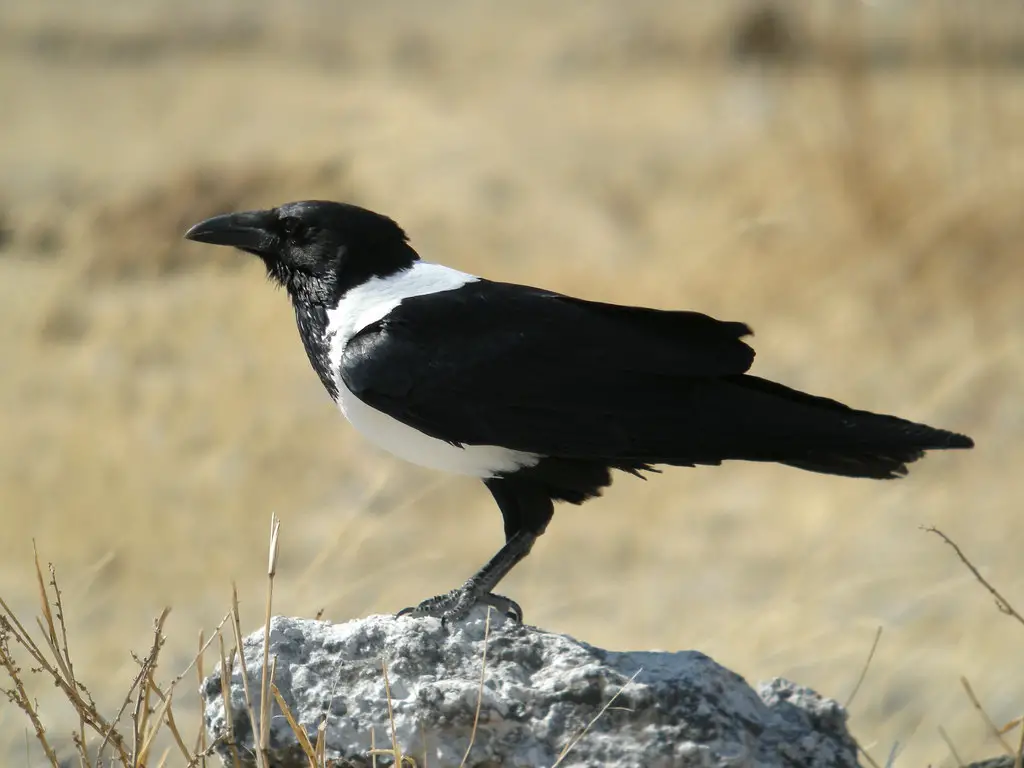
Image Source
- Scientific name: Corvus albus
- Lifespan: Up to 14 years
- Size: 46-48 centimeters (18-19 inches)
- Weight: 450-550 grams (16-19 ounces)
- Origin: Sub-Saharan Africa and Madagascar
The Pied Crow (Corvus albus) is a large and intelligent bird belonging to the crow family. It is found in sub-Saharan Africa and parts of the Arabian Peninsula. The Pied Crow has a black body with a contrasting white chest, neck, and head. It inhabits a wide range of habitats, including forests, savannas, and urban areas. Known for its opportunistic feeding habits, the Pied Crow consumes a varied diet that includes insects, small mammals, birds, fruits, and carrion. With its bold and charismatic presence, the Pied Crow is a common sight in many African landscapes.
Purple Martin

- Scientific name: Progne subis
- Lifespan: 5 to 7 years
- Size: 7.5 to 8.5 inches
- Native to: North America
The Purple Martin (Progne subis) is a well-known and widely loved bird in North America. It is the largest swallow species in the region. The adult male has a dark, glossy purple plumage, while the female is slightly duller with grayish tones. Purple Martins are highly migratory, spending their breeding season in North America and migrating to South America for the winter. They prefer open habitats near water, such as fields, meadows, and wetlands. Known for their aerial acrobatics, Purple Martins feed on flying insects that they catch while in flight. With their enchanting songs and aerial displays, Purple Martins bring joy and beauty to the skies.
Pheasant Cuckoo:

Image Source
- Scientific name: Dromococcyx phasianellus
- Lifespan: Up to 5 years
- Size: 32-36 centimeters (13-14 inches)
- Weight: 55-80 grams (1.9-2.8 ounces)
- Origin: Central and South America
The Pheasant Cuckoo (Dromococcyx phasianellus) is a unique bird species found in Central and South America. As its name suggests, it has physical characteristics resembling both a pheasant and a cuckoo. This secretive bird has a brown plumage with intricate patterns, allowing it to blend into its forested habitats. It has a long tail and a slightly curved bill. The Pheasant Cuckoo is known for its distinctive call, which sounds like a series of deep, low-pitched hoots. It primarily feeds on insects, small reptiles, and fruits. Due to its secretive nature and elusive behavior, observing a Pheasant Cuckoo in the wild is a rare and exciting experience.
Pacific Loon:
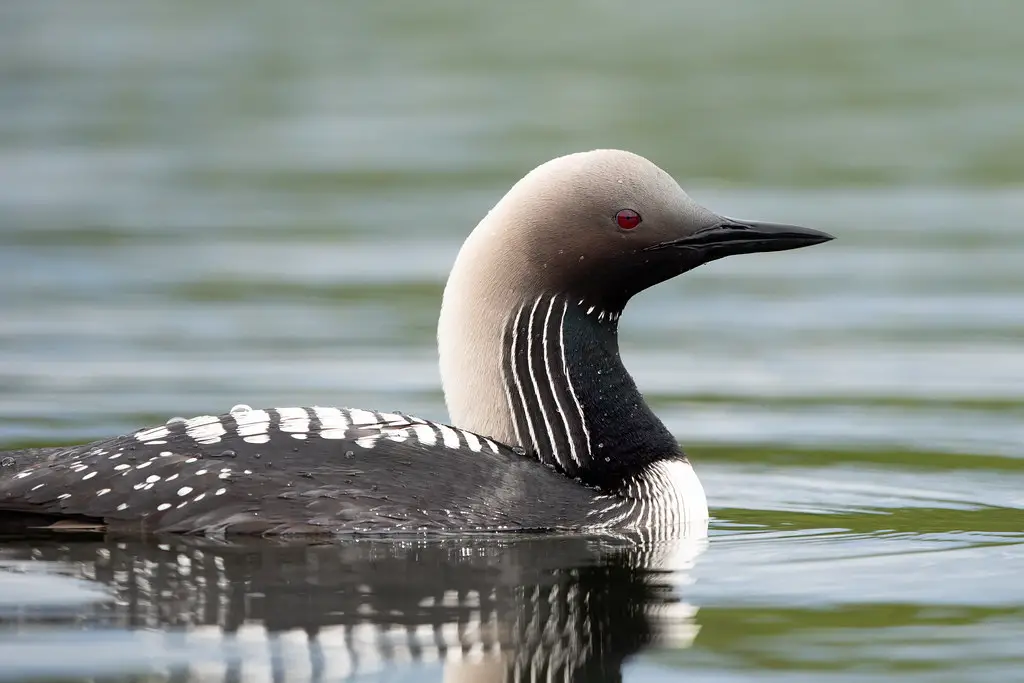
Image Source
- Scientific name: Gavia pacifica
- Lifespan: Up to 20 years
- Size: 58-76 centimeters (23-30 inches)
- Weight: 1.4-3.2 kilograms (3-7 pounds)
- Origin: North America (breeding in arctic regions)
The Pacific Loon (Gavia pacifica) is a species of diving bird found in the coastal regions of North America and Asia. It is known for its striking black and white plumage and its ability to swim and dive underwater for extended periods. During the breeding season, the Pacific Loon displays a black head and neck with a white checkered pattern on its back. It inhabits large bodies of water such as lakes, coastal bays, and open oceans. This bird feeds primarily on fish and crustaceans. The haunting calls of the Pacific Loon can often be heard echoing across the serene waters it calls home.
Piping Plover: (Birds that Start with P)
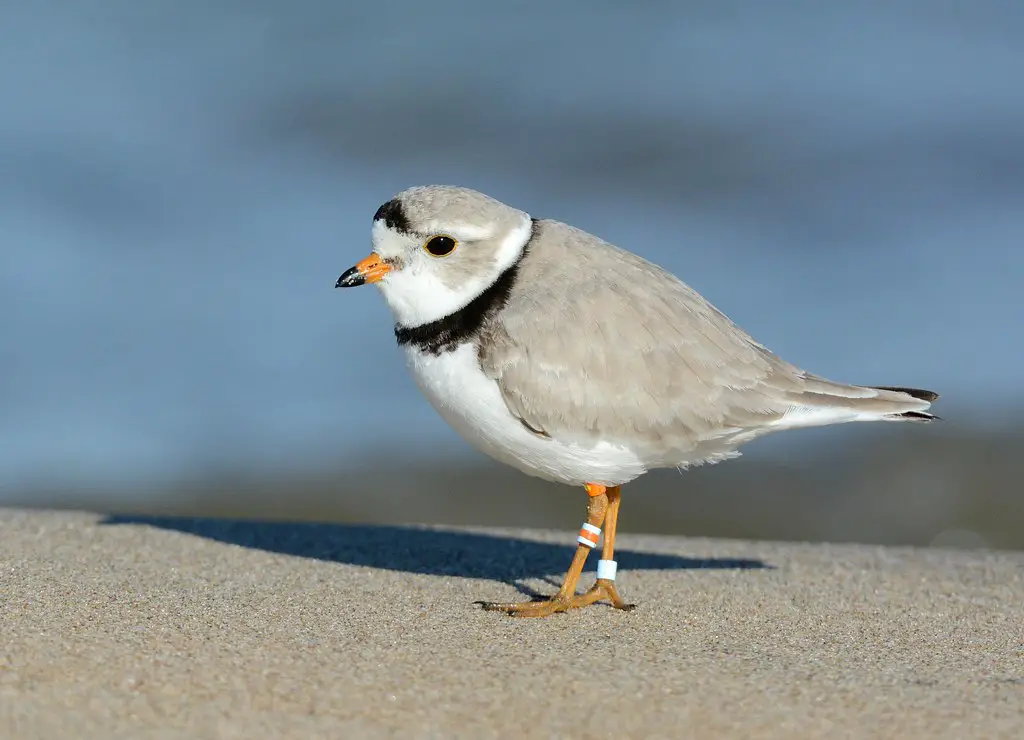
Image Source
- Scientific name: Charadrius melodus
- Lifespan: Up to 10 years
- Size: 17-19 centimeters (7-8 inches)
- Weight: 43-64 grams (1.5-2.3 ounces)
- Origin: North America (breeding in coastal areas)
The Piping Plover (Charadrius melodus) is a small shorebird species found along the coastlines of North America. It is known for its pale brown upperparts, white underparts, and a distinctive black band across its forehead. Piping Plovers prefer sandy beaches, sandbars, and coastal dunes as their nesting and foraging habitats. They feed on small invertebrates, such as insects and crustaceans, found along the shoreline. Piping Plovers are famous for their distinctive “piping” calls, which give them their name. Due to habitat loss and disturbance, this species is considered threatened in many areas, making conservation efforts crucial to their survival.
Pygmy Falcon:

Image Source
- Scientific name: Polihierax semitorquatus
- Lifespan: Up to 8 years
- Size: 19-21 centimeters (7.5-8.3 inches)
- Weight: 45-60 grams (1.6-2.1 ounces)
- Origin: Sub-Saharan Africa, Southwest Asia, and the Indian Subcontinent
The Pygmy Falcon (Polihierax semitorquatus) is a small falcon species found in parts of Africa. It is known for its diminutive size and vibrant plumage. The male has a striking combination of gray, black, and white feathers, while the female has a more muted appearance. The Pygmy Falcon is often found in open woodlands, savannas, and semi-arid regions. It primarily feeds on insects, small birds, and lizards, which it captures with swift and agile flights. Despite its small size, the Pygmy Falcon is a formidable predator in its habitat. Its presence adds charm and grace to the African landscapes it calls home.
Pacific Screech-Owl:
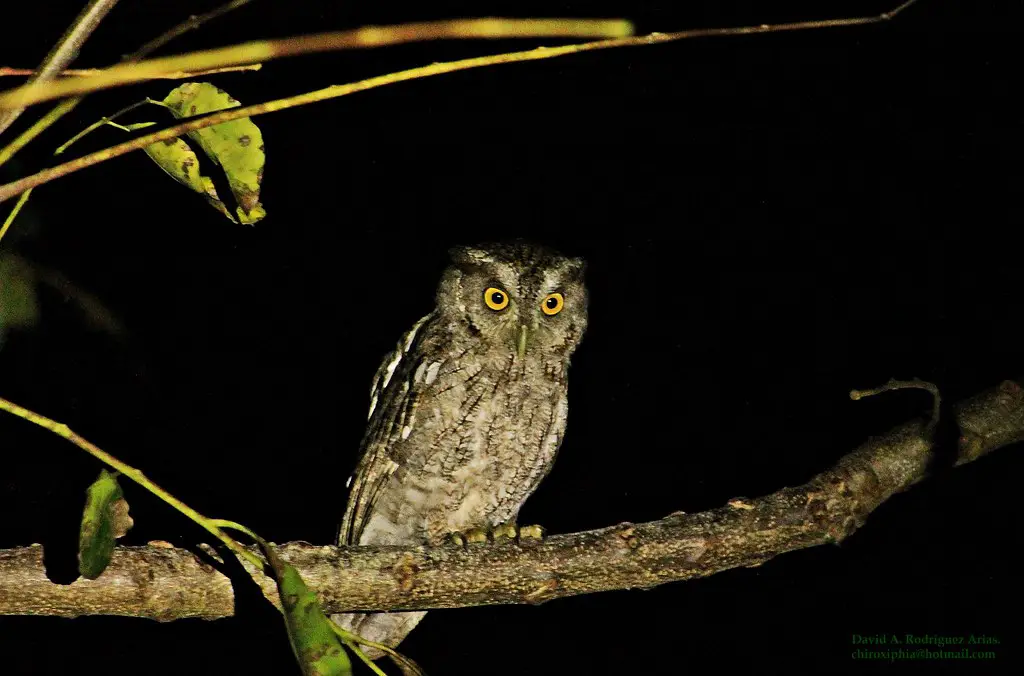
Image Source
- Scientific name: Megascops cooperi
- Lifespan: Up to 14 years
- Size: 18-25 centimeters (7-10 inches)
- Weight: 150-200 grams (5.3-7.1 ounces)
- Origin: Western North America (from Canada to Mexico)
The Pacific Screech-Owl (Megascops cooperi) is a small owl species found in the western regions of North and Central America. It is known for its distinct facial pattern, consisting of dark eyes with pale eyebrows and a streaked crown. This nocturnal bird inhabits various forested habitats, including woodlands, forests, and riparian areas. As its name suggests, it produces screeching calls that echo through the night. The Pacific Screech-Owl primarily feeds on small mammals, birds, insects, and reptiles. Its well-developed hearing and silent flight make it an efficient hunter. The Pacific Screech-Owl is a captivating and mysterious resident of the night, adding enchantment to the forests it inhabits.
Pigeon Guillemot:
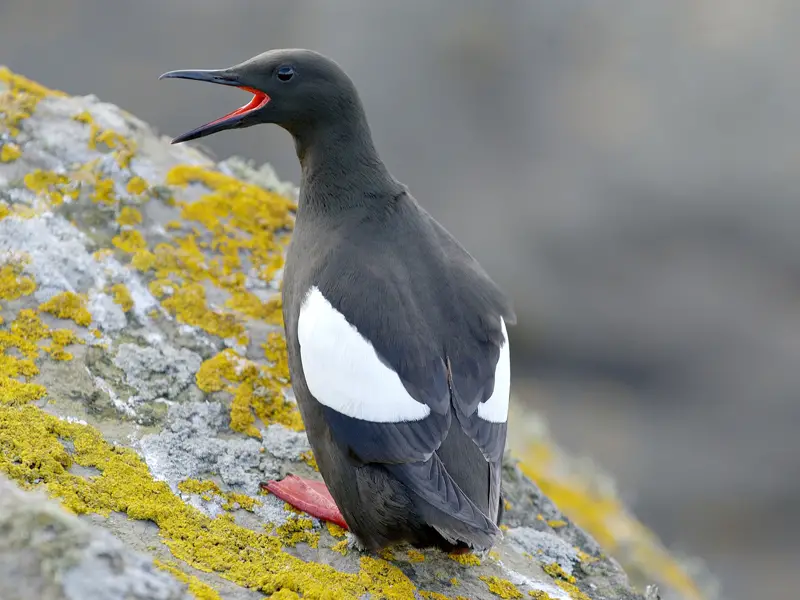
Image Source
- Scientific name: Cepphus columba
- Lifespan: 10-15 years
- Size: 34-40 centimeters (13-16 inches)
- Origin: North Pacific coastal regions
The Pigeon Guillemot (Cepphus columba) is a seabird species found along the coastlines of the northern Pacific Ocean. It is known for its striking appearance, with a black body, white wing patches, and bright red legs and feet. During the breeding season, its plumage undergoes a transformation, displaying a white patch on the wing and a distinct white line around the eye. Pigeon Guillemots nest in rocky crevices or burrows near the shore. They are skilled divers, using their wings to propel themselves underwater in search of fish and invertebrates. These charismatic birds bring life and beauty to the coastal habitats they call home.
Purple Gallinule

- Scientific name: Porphyrio martinicus
- Lifespan: 7 years
- Size: 10–15 in
- Native to: Southern Florida, the Gulf and Pacific coast of Mexico, parts of Central America, and the Caribbean
The Purple Gallinule (Porphyrio martinicus) is a colorful waterbird species found in wetlands and marshes of the Americas. It displays vibrant plumage, including hues of purple, blue, green, and red. With its long legs and toes, it can walk on floating vegetation, making it well adapted to its habitat. The Purple Gallinule is known for its distinctive loud call, which it often uses to communicate with its flock members. It primarily feeds on a variety of plant matter, insects, small fish, and crustaceans. Observing the Purple Gallinule in its wetland habitat is a delightful experience, as it gracefully moves through the vegetation.
Pelagic Cormorant:
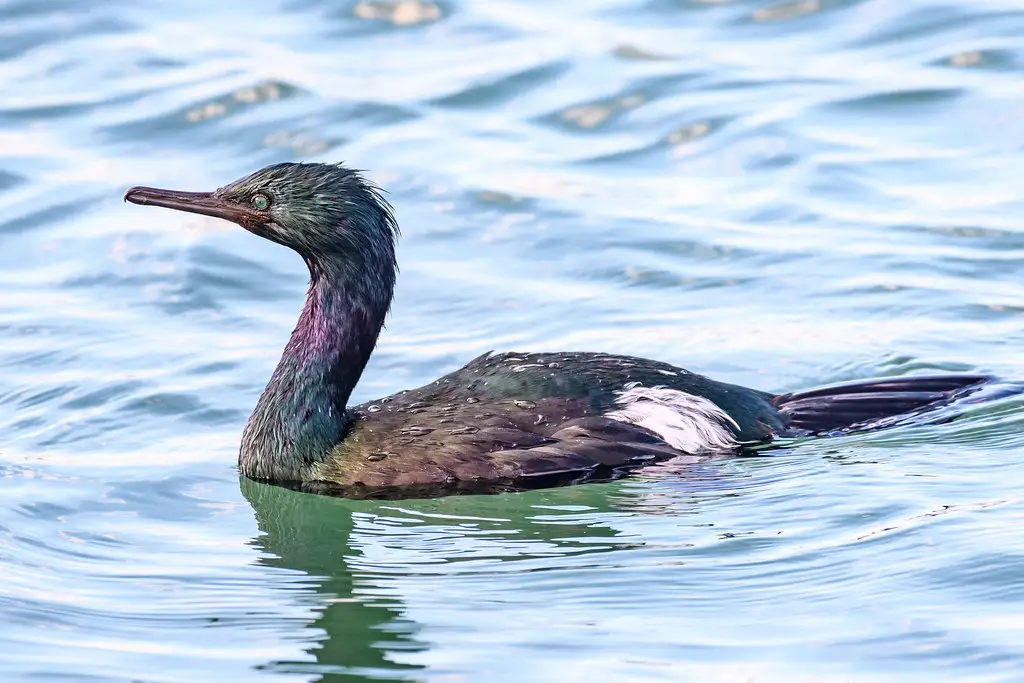
Image Source
- Scientific name: Phalacrocorax pelagicus
- Lifespan: Up to 17 years
- Size: 64-82 centimeters (25-32 inches)
- Weight: 1-1.6 kilograms (2.2-3.5 pounds)
- Origin: Pacific coastal regions of North America
The Pelagic Cormorant (Phalacrocorax pelagicus) is a seabird species that inhabits the coastal regions of the northern Pacific Ocean. It is known for its slender body, long neck, and dark plumage. During the breeding season, adult Pelagic Cormorants display white plumes on their neck and shoulders. These cormorants nest on cliffs and rocky outcrops near the shore, often forming large colonies. They are excellent divers, using their webbed feet to propel themselves underwater in search of fish and marine invertebrates. Their characteristic flight pattern, with quick wingbeats and low glides, is a common sight along the coast. The Pelagic Cormorant is a fascinating marine bird that thrives in the dynamic ocean environment.
Parakeet Auklet:
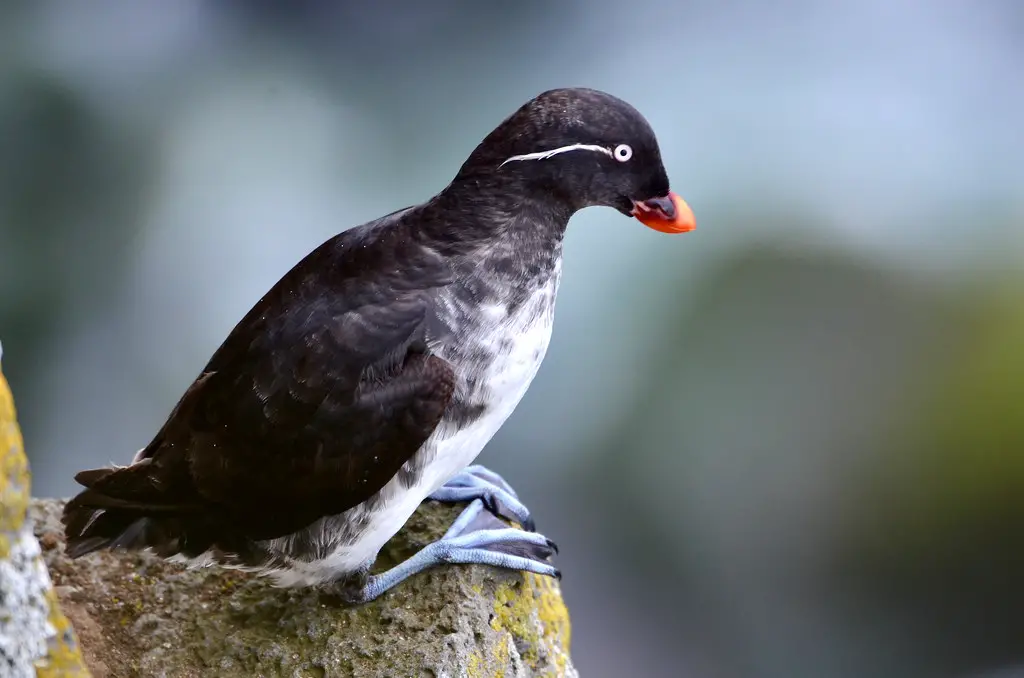
Image Source
- Scientific name: Aethia psittacula
- Lifespan: Up to 14 years
- Size: 20-24 centimeters (8-9.5 inches)
- Weight: 170-240 grams (6-8.5 ounces)
- Origin: North Pacific Ocean (breeding in Alaska and Russia)
The Parakeet Auklet (Aethia psittacula) is a small seabird species found in the North Pacific Ocean. It gets its name from its vibrant plumage, which resembles the colors of a parakeet. With its short wings and compact body, the Parakeet Auklet is well adapted for life at sea. It nests in burrows or crevices on rocky cliffs or islands. This bird primarily feeds on small fish and zooplankton, which it catches by diving underwater. The Parakeet Auklet’s distinctive calls, including nasal honks and growls, are a common sound around its breeding colonies. It is a charming and endearing member of the diverse seabird community.
Painted Stork:
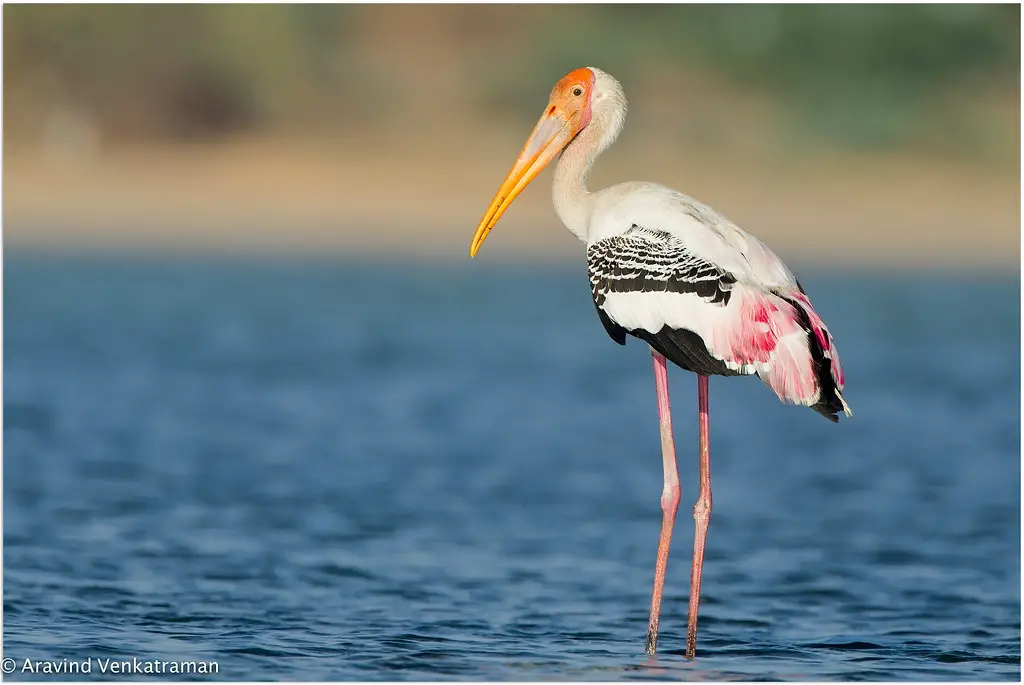
Image Source
- Scientific name: Mycteria leucocephala
- Lifespan: Up to 25 years
- Size: 93-102 centimeters (37-40 inches)
- Weight: 2.5-4.5 kilograms (5.5-10 pounds)
- Origin: South Asia, Southeast Asia, and Indonesia
The Painted Stork (Mycteria leucocephala) is a large wading bird found in parts of South and Southeast Asia. It is known for its striking plumage, with a white body, black wing feathers, and a pinkish head and neck. The Painted Stork derives its name from the vibrant pink, red, and orange patches on its wings, which become more prominent during the breeding season. It feeds primarily on fish and aquatic invertebrates, often foraging in shallow wetlands and marshes. The Painted Stork nests in colonies, building large stick nests on trees or man-made structures. Its graceful flight and elegant appearance make it a captivating sight in the wetland habitats it frequents.
Pinnated Bittern: (Birds that Start with P)
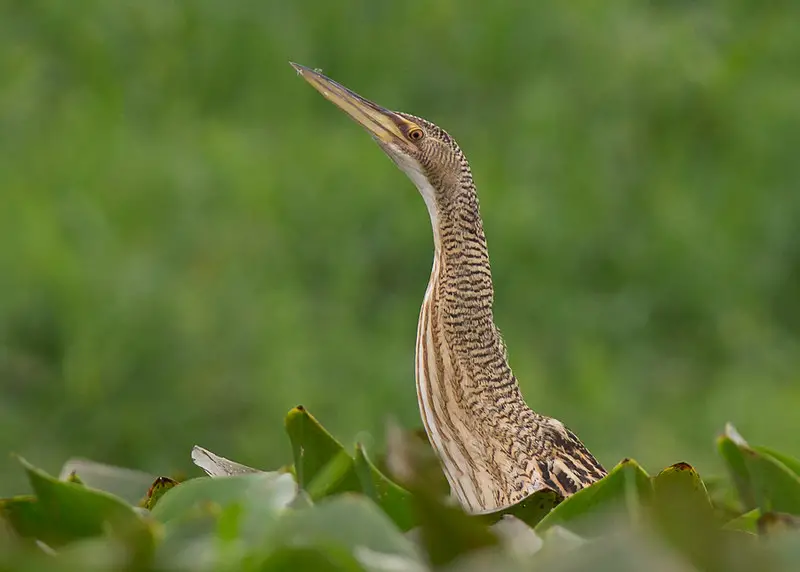
Image Source
- Scientific name: Botaurus pinnatus
- Lifespan: Up to 11 years
- Size: 70-80 centimeters (28-31 inches)
- Weight: 500-700 grams (1.1-1.5 pounds)
- Origin: South America
The Pinnated Bittern (Botaurus pinnatus) is a large heron-like bird species found in parts of North and South America. It is known for its distinctive appearance, with long legs, a long neck, and mottled brown plumage that provides excellent camouflage in marshy habitats. The Pinnated Bittern is primarily active during dusk and dawn, relying on its stealth and cryptic plumage to blend in with its surroundings. It feeds on a variety of prey, including fish, amphibians, reptiles, and small mammals. When threatened, it adopts a behavior known as “bitterning,” where it stretches its neck upward and sways from side to side to blend in with the surrounding vegetation. The Pinnated Bittern is a fascinating and elusive bird of the wetlands.
Peruvian Pelican:
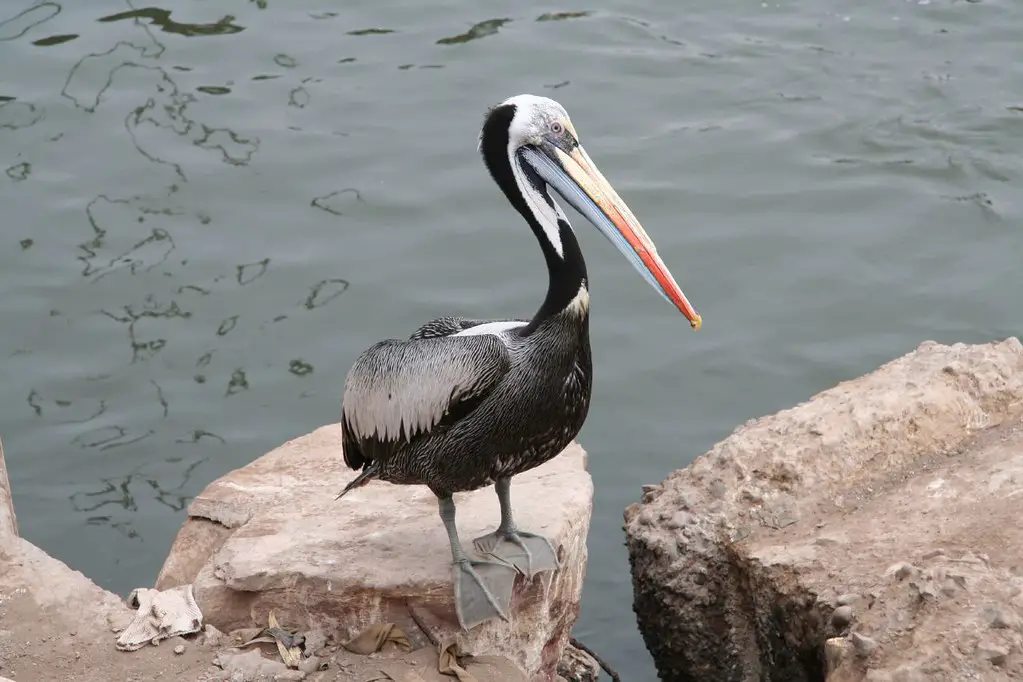
Image Source
- Scientific name: Pelecanus thagus
- Lifespan: Up to 15 years
- Size: 122-152 centimeters (48-60 inches)
- Weight: 4-7 kilograms (8.8-15.4 pounds)
- Origin: Western South America (coastal regions)
The Peruvian Pelican (Pelecanus thagus) is a large seabird species found along the Pacific coast of South America, particularly in Peru and Chile. It is one of the largest pelican species, with a wingspan of over 6 feet (2 meters). The Peruvian Pelican has a distinct appearance, with a white body, grayish-brown wings, and a long, straight, yellowish bill. It feeds primarily on fish, using its large throat pouch to scoop up its prey from the water. These pelicans are often seen flying in formation or perched on rocks near the shore. Their presence adds to the coastal beauty of the region and their graceful dives into the water are a remarkable sight to behold.
Peaceful Dove:
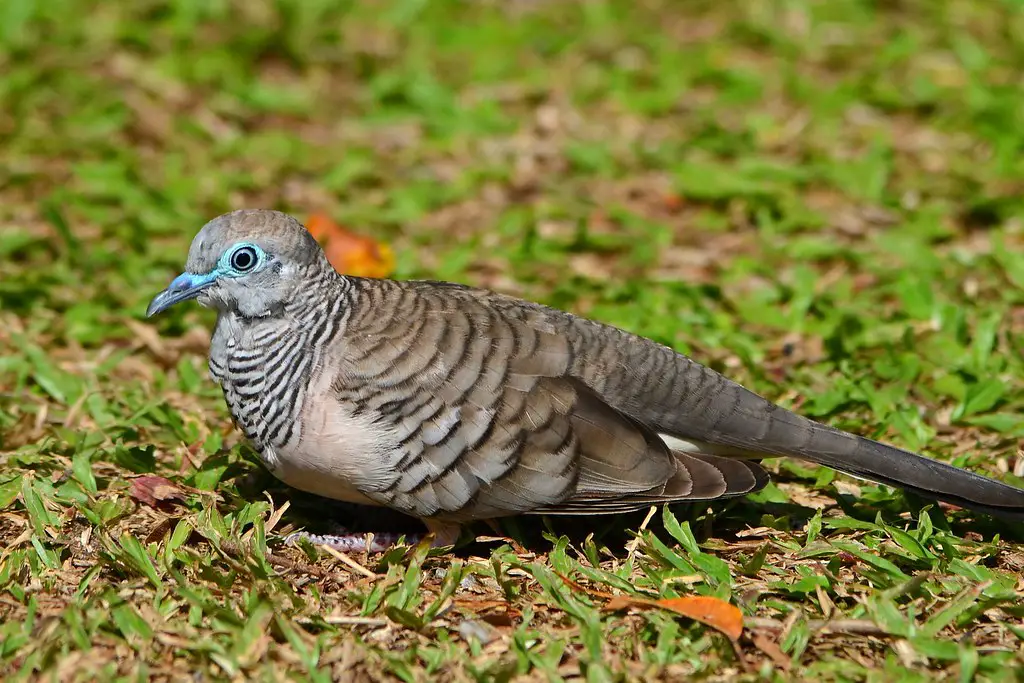
Image Source
- Scientific name: Geopelia striata
- Lifespan: Up to 12 years
- Size: 20-24 centimeters (8-9.5 inches)
- Weight: 50-80 grams (1.8-2.8 ounces)
- Origin: Australia, Indonesia, and Papua New Guinea
The Peaceful Dove (Geopelia placida) is a small dove species native to Australia and Indonesia. It is known for its gentle nature and soft, melodious cooing sounds. The Peaceful Dove has a pale gray-brown plumage, with a speckled breast and dark spots on its wings. It primarily feeds on seeds and grains found on the ground, often foraging in small flocks. These doves are commonly found in open woodlands, grasslands, and agricultural areas. Their peaceful and unassuming presence adds a touch of serenity to their habitats, and their melodic calls provide a soothing soundtrack to the surrounding environment.
Pink-Footed Goose:
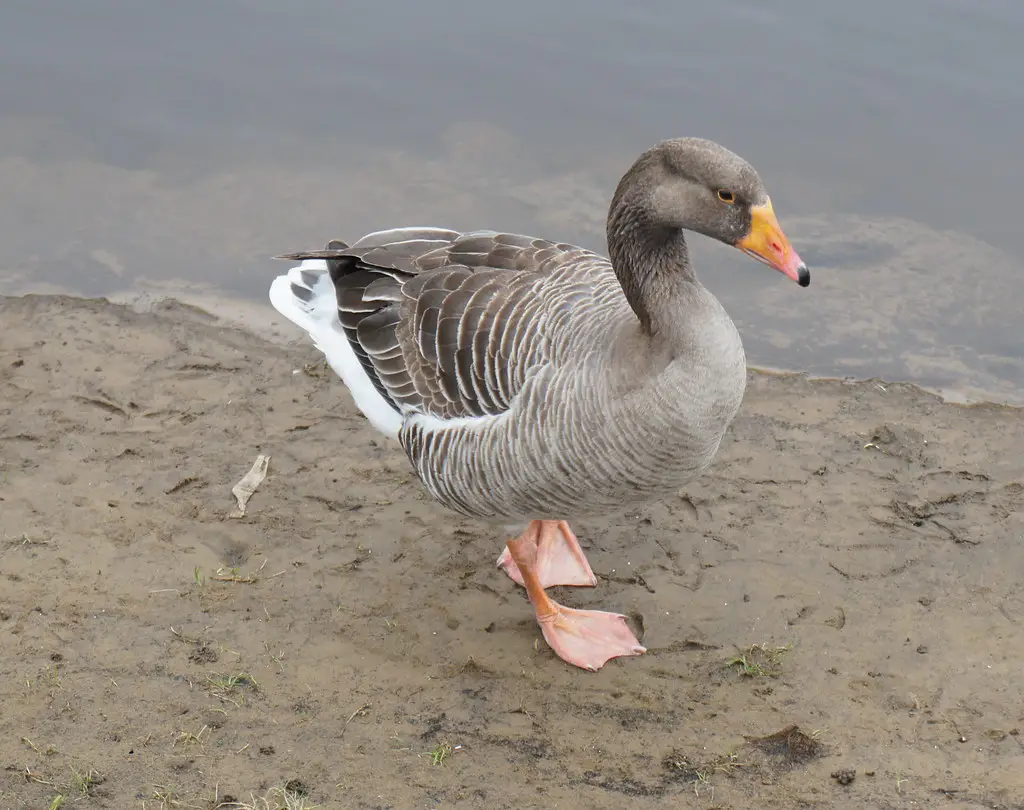
Image Source
- Scientific name: Anser brachyrhynchus
- Lifespan: Up to 12 years
- Size: 64-79 centimeters (25-31 inches)
- Weight: 2.3-3.4 kilograms (5-7.5 pounds)
- Origin: Greenland, Iceland, and northern Europe
The Pink-Footed Goose (Anser brachyrhynchus) is a medium-sized goose species native to Arctic regions, particularly Greenland, Iceland, and Svalbard. It is named after its distinctive pink feet, which stand out against its gray-brown plumage. The Pink-Footed Goose is a migratory bird, traveling long distances between its breeding grounds in the Arctic and its wintering grounds in Western Europe. It feeds on grasses, sedges, and agricultural crops. These geese are known for their distinctive honking calls and their V-shaped flight formations during migration. Their presence in wetlands and coastal areas adds to the natural beauty of these habitats, and their synchronized movements in flight are a captivating sight.
Pink Pigeon:
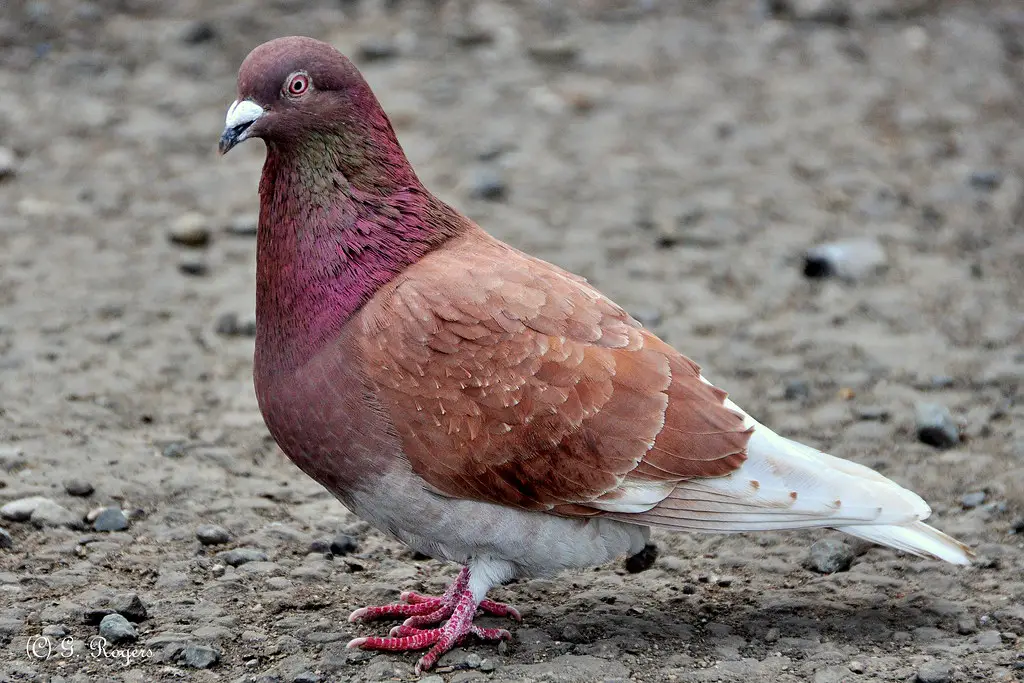
Image Source
- Scientific name: Nesoenas mayeri
- Lifespan: Up to 15 years
- Size: 33-36 centimeters (13-14 inches)
- Weight: 300-350 grams (10.6-12.3 ounces)
- Origin: Mauritius
The Pink Pigeon (Nesoenas mayeri) is a critically endangered bird species endemic to the island of Mauritius in the Indian Ocean. It is named after its unique pinkish plumage, which sets it apart from other pigeon species. The Pink Pigeon is known for its distinctive calls and its ability to feed on a variety of fruits, seeds, and leaves found in its forested habitat. Conservation efforts have been successful in saving this species from the brink of extinction, and ongoing initiatives continue to protect its remaining population. The Pink Pigeon serves as an important symbol of conservation and the need to preserve fragile ecosystems and endangered species.
Purplish Jay

- Scientific name: Cyanocorax cyanomelas
- Lifespan: n/a
- Size: 14 and 16 in
- Native to: Southeastern Peru and northern Bolivia south to Paraguay, southwestern Brazil and northern Argentina
The Corvidae family of birds, which includes nutcrackers, crows, ravens, jays, magpies, and other birds, includes the purple jay.
They are the biggest passerine bird on this list, along with a few others. Countries including northern Argentina, Bolivia, southern Brazil, and Paraguay are home to the purple jay.
Different types of forests, such as lowland forests and subtropical or tropical dry forests, are preferred habitats. They consume fruits, eggs, reptiles, eggs, and insects.
Pied Plover: (Birds that Start with P)

Image Source
- Scientific name: Hoploxypterus cayanus
- Lifespan: Up to 15 years
- Size: 17-20 centimeters (6.7-7.9 inches)
- Weight: 70-80 grams (2.5-2.8 ounces)
- Origin: South America
The Pied Plover (Vanellus cayanus), also known as the Pied Lapwing, is a striking bird species found in parts of South America, particularly in the wetlands and grasslands of the Amazon Basin. It is known for its black and white plumage, with a distinctive pattern of contrasting colors on its wings, head, and chest. The Pied Plover feeds on a variety of invertebrates, such as insects, worms, and small crustaceans, found in the muddy or sandy areas where it resides. It is often observed running along the ground, pausing to probe the soil for prey. The Pied Plover’s graceful movements and striking appearance make it a captivating sight in its natural habitat.
Peruvian Booby:
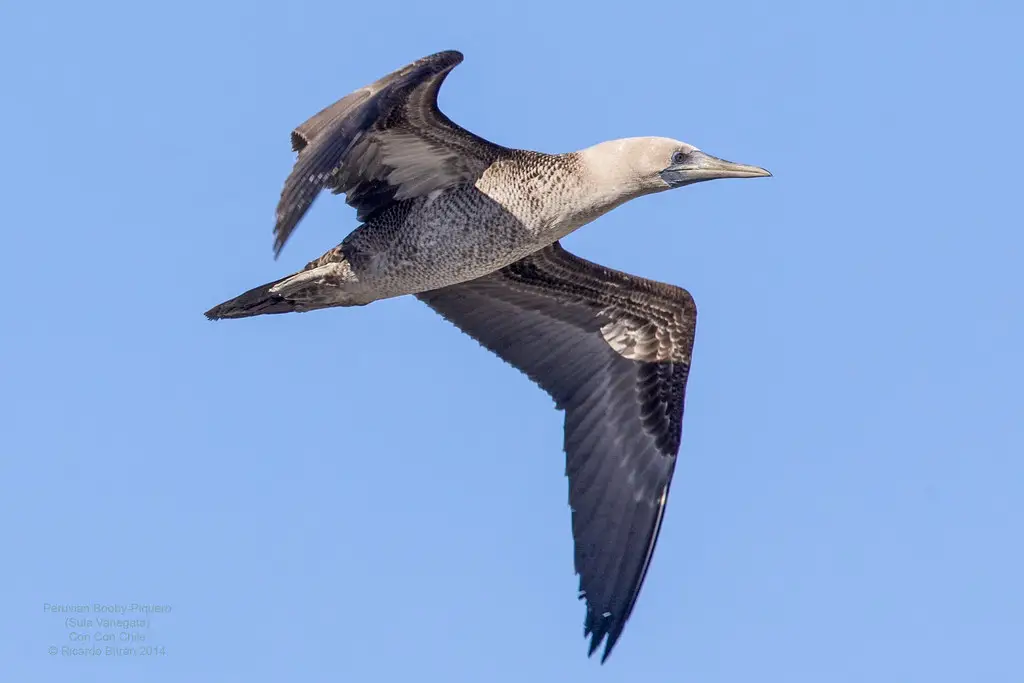
Image Source
- Scientific name: Sula variegata
- Lifespan: Up to 18 years
- Size: 70-80 centimeters (28-31 inches)
- Weight: 1.8-2.5 kilograms (4-5.5 pounds)
- Origin: Coastal regions of Peru and Chile
The Peruvian Booby (Sula variegata) is a seabird species found along the Pacific coast of South America, particularly in Peru and Chile. It is known for its distinct black and white plumage, with a pale blue beak and feet. The Peruvian Booby primarily feeds on fish, which it catches by plunge-diving into the ocean from great heights. It forms large breeding colonies on coastal cliffs and islands, where it constructs nests using vegetation and guano. The Peruvian Booby’s colonies are known for their loud and raucous calls, which create a bustling atmosphere. Its presence adds to the coastal biodiversity and the beauty of marine ecosystems.
Pileated woodpecker

Image Source
- Scientific name: Dryocopus pileatus
- Lifespan: Up to 11 years
- Weight: 250-400 grams
- Size: 40-49 cm
- Origin: North America
The Pileated Woodpecker (Dryocopus pileatus) is a large woodpecker species found in North America. It is known for its distinctive appearance, with a prominent red crest, a black body, and white stripes on its face. The Pileated Woodpecker is an expert at excavating large holes in dead trees in search of insects, particularly wood-boring beetles. Its powerful beak and long tongue allow it to reach deep into tree trunks to extract its prey. The Pileated Woodpecker’s loud drumming on trees is a characteristic sound of mature forests. It is often seen hopping up tree trunks or flying between trees, adding vibrancy to woodland habitats.
Purple Sandpiper:
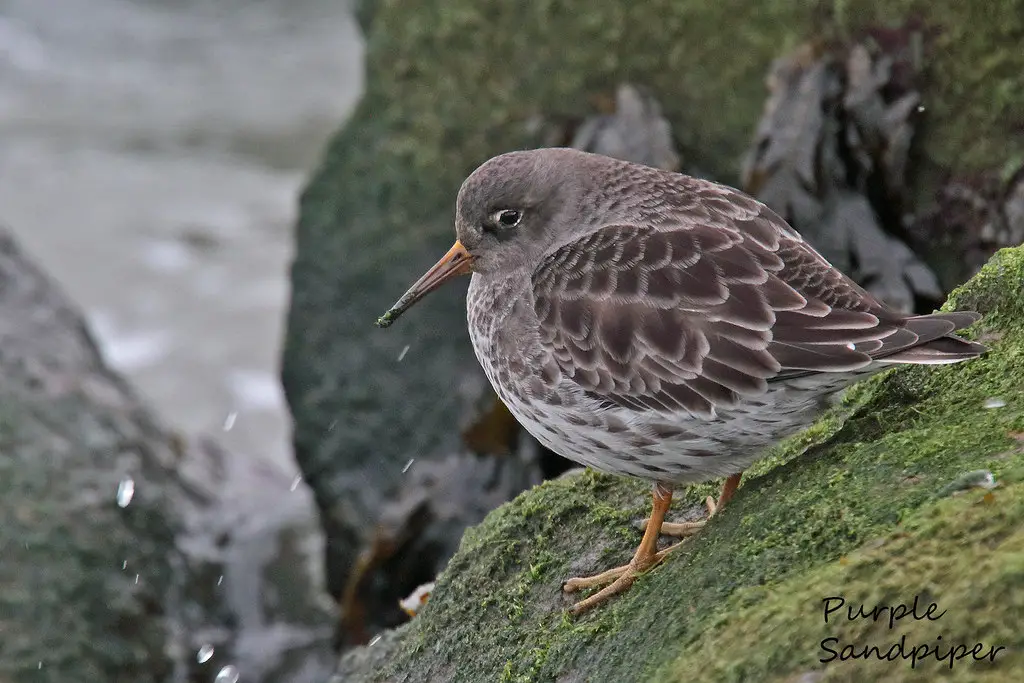
Image Source
- Scientific name: Calidris maritima
- Lifespan: Up to 13 years
- Size: 20-25 centimeters (8-10 inches)
- Weight: 60-80 grams (2.1-2.8 ounces)
- Origin: Arctic regions (breeding) and coastal areas of North America and Europe (wintering)
The Purple Sandpiper (Calidris maritima) is a small shorebird species found in the Northern Hemisphere, particularly in coastal regions of the Arctic and subarctic. Despite its name, the Purple Sandpiper’s plumage is mostly gray with subtle purple hues on its back and wings. It is well-adapted to rocky shores and rugged coastlines, where it forages for invertebrates such as insects, crustaceans, and mollusks. The Purple Sandpiper’s ability to withstand harsh weather conditions and its preference for rocky habitats make it a unique and specialized species. Its presence along rocky shorelines adds a touch of color and vitality to these coastal environments.
Purple Grenadier

- Scientific name: Uraeginthus ianthinogaster
- Lifespan: 7 years
- Size: 5.25 in
- Native to: Ethiopia, Kenya, Somalia, South Sudan, Tanzania and Uganda
The purple grenadier is a species of passerine bird that belongs to the Estrildidae family, sometimes known as the estrildid finches.
This bird species lives in tropical and subtropical shrublands, and you may find it in places like Ethiopia, Somalia, South Sudan, Tanzania, and Uganda.
Small birds, measuring up to 5.25 inches, are called purple grenadiers. The mature birds’ bills are crimson, but their tails are all black.
While females are predominantly cinnamon brown with a white underpart, males have purple tints on their rumps and underparts. The eyes of both sexes have patches.
Puerto Rican Woodpecker:
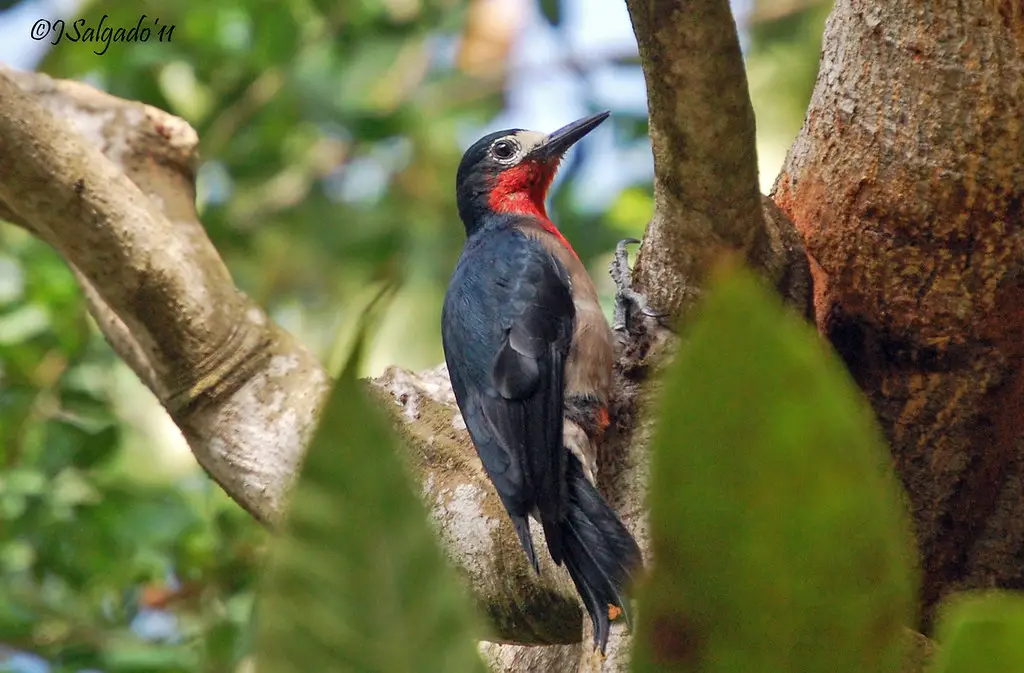
Image Source
- Scientific name: Melanerpes portoricensis
- Lifespan: Up to 10 years
- Size: 24-26 centimeters (9.4-10.2 inches)
- Weight: 56-73 grams (2-2.6 ounces)
- Origin: Puerto Rico
The Puerto Rican Woodpecker (Melanerpes portoricensis) is a bird species endemic to the island of Puerto Rico in the Caribbean. It is a medium-sized woodpecker with black and white plumage, a red crown, and a sturdy bill. This woodpecker is known for its strong drumming sounds, which it produces by pecking on tree trunks to communicate and establish territories. It feeds primarily on insects and larvae found in trees, using its specialized bill to extract prey from crevices. The Puerto Rican Woodpecker plays an important ecological role in Puerto Rico’s forests and is considered a symbol of the island’s biodiversity and natural heritage.
Pale-Vented Pigeon:
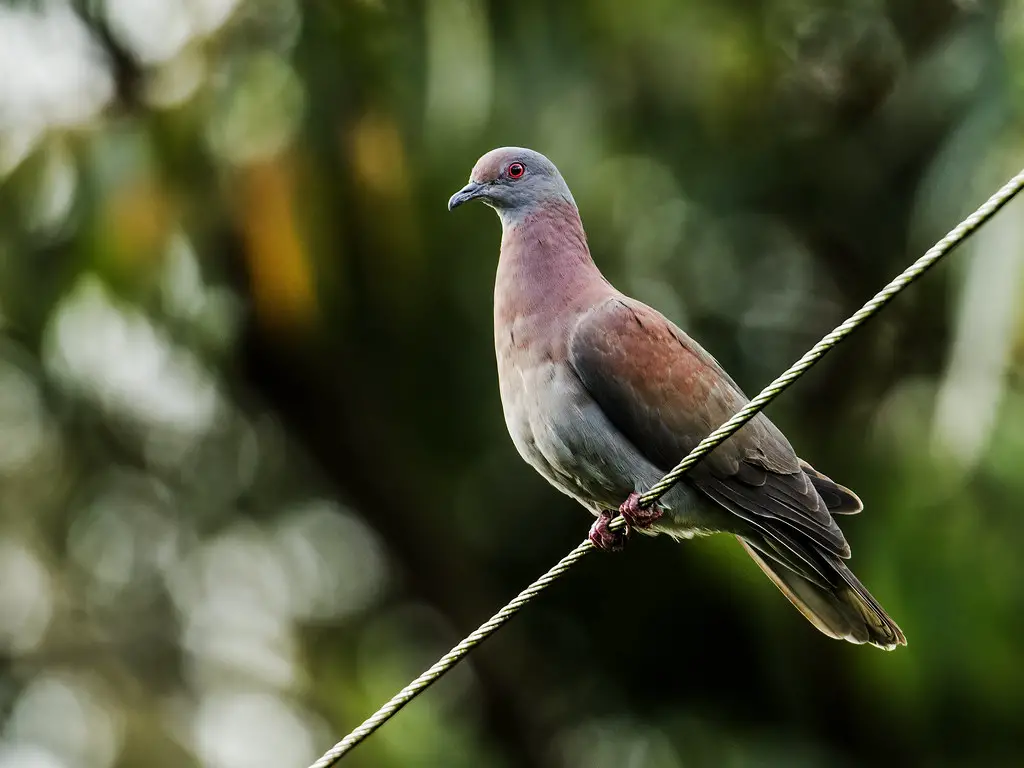
Image Source
- Scientific name: Patagioenas cayennensis
- Lifespan: Up to 12 years
- Size: 30-33 centimeters (12-13 inches)
- Weight: 200-250 grams (7-8.8 ounces)
- Origin: Central and South America
The Pale-Vented Pigeon (Patagioenas cayennensis) is a pigeon species found in various regions of the Americas, including parts of South America, Central America, and the Caribbean. It is a medium-sized pigeon with a pale gray body, a distinctive white patch on its wings, and a pale vent area. The Pale-Vented Pigeon inhabits a range of habitats, including forests, savannas, and agricultural areas. It feeds on a variety of seeds, fruits, and grains. Its cooing calls can often be heard resonating through its habitat. The Pale-Vented Pigeon’s gentle nature and attractive plumage make it a delightful sight for birdwatchers and nature enthusiasts.
Purple Heron (Birds that Start with P)
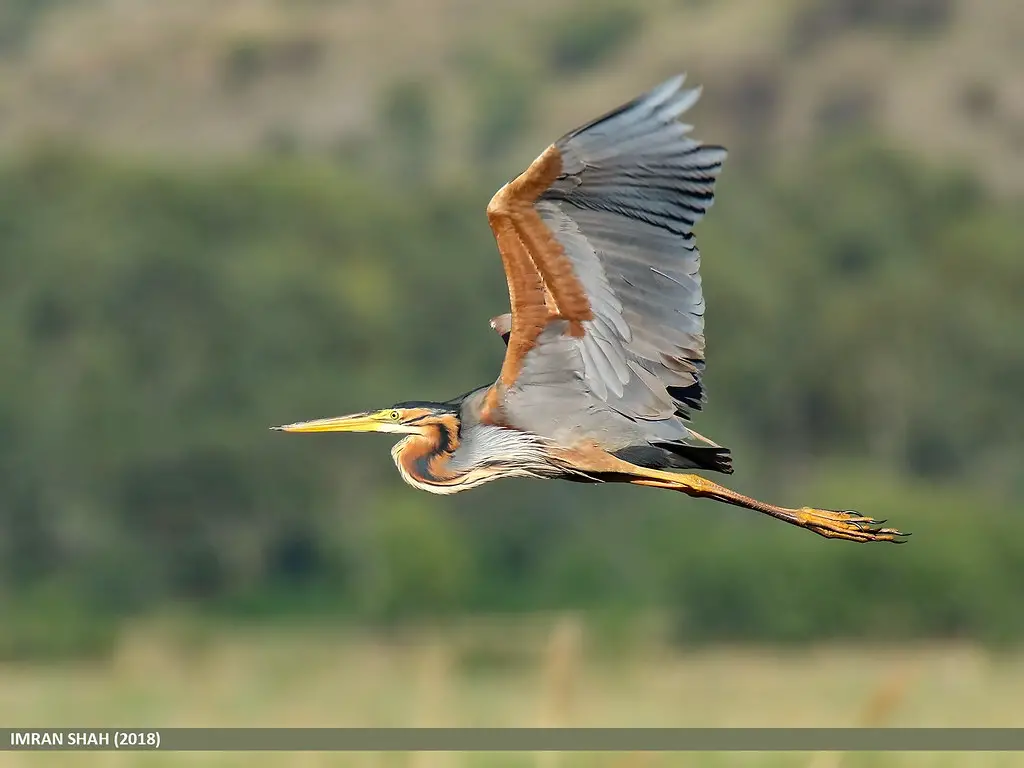
- Scientific name: Ardea purpurea
- Lifespan: 20 years
- Size: 31–38 in
- Native to: Central and southern Europe and parts of North Africa as far as Lake Balkhash in Kazakhstan
The Purple Heron (Ardea purpurea) is a large wading bird found across Europe, Africa, and parts of Asia. During the breeding season, it displays a distinctive plumage, showcasing a predominantly gray body and adorning its neck, head, and chest with a vibrant purple coloration. The Purple Heron inhabits wetland habitats such as marshes, lakes, and rivers, where it wades through shallow water in search of fish, amphibians, and other aquatic prey. It’s long legs and sharp bill make it a skilled hunter. The Purple Heron’s graceful flight and striking appearance make it a sought-after species for birdwatchers and nature photographers.
Pine Siskin:
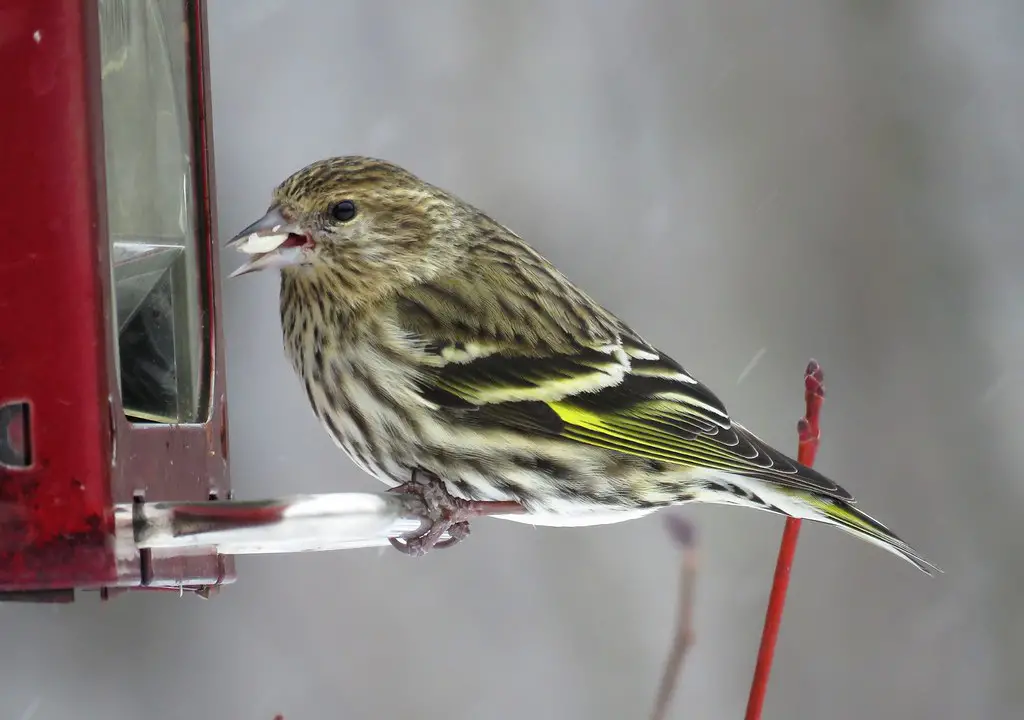
Image Source
- Scientific name: Spinus pinus
- Lifespan: Up to 10 years
- Size: 11-14 centimeters (4-5.5 inches)
- Weight: 11-18 grams (0.4-0.6 ounces)
- Origin: North America (forests and woodlands)
The Pine Siskin (Spinus pinus) inhabits North America, specifically coniferous forests, and it is a small finch species. It possesses streaked brown plumage, yellow wing bars, and a pointed bill. The Pine Siskin exhibits a high level of adaptation for feeding on conifer tree seeds, including pine and spruce. It forms flocks and often visits bird feeders during the winter when natural food sources are scarce. The Pine Siskin’s melodic chirps and acrobatic flight add liveliness to forested areas. Its ability to survive in harsh climates and its unique feeding habits make it an intriguing bird species to observe.
Purple-breasted Cotinga

Image Source
- Scientific name: Selasphorus rufus
- Lifespan: upto 15 years
- Size: 7 in
- Native to: Brazil, Colombia, French Guiana, Guyana, Peru, Suriname, and Venezuela
The family Cotingidae, which includes more than 100 species of cotingas, includes the purple-breasted cotinga. The purple-breasted cotinga loves woodlands, particularly damp rainforests.
They can hide from any prospective predators because of their purple coloring, which also works well for mating. This species of cotinga is a frugivore, much like every other bird species in the Cotingidae family (their diet consists of fruits).
It can reach a maximum height of 13 inches and may weigh between 32 and 39g. The purple-breasted cotinga, as its name implies, has purple coloration over the breast region, as well as the wings, head, neck, and back.
Purple Honeycreeper

- Scientific name: Cyanerpes caeruleus
- Lifespan: 17 years
- Size: 4.5 in
- Native to: Colombia and Venezuela south to Brazil, and on Trinidad
The family Thraupidae, usually referred to as the tanager family, includes the purple honeycreeper. Typically in the northern regions of the continent, it is mostly found in South America.
It lives in plantations, notably those growing cocoa and citrus, although its natural home is in the canopies of forests. These birds are tiny, at 4.5 inches tall, and weighing 12g.
They are gregarious birds that hang together in small groups and eat plant nectars like butterflies. They also eat seeds, fruits, and insects. Compared to females, who tend to be green, males have more purple hues.
Purple Starling

- Scientific name: Lamprotornis purpureus
- Lifespan: 3 to 6 years
- Size: 3-inch
- Native to: Tropical Africa from Senegal and north Zaire east to Sudan and west Kenya
The Sturnidae family of starlings includes the purple starling. It lives in tropical Africa, notably in nations like Senegal and Sudan, and is also known as the purple glossy starling.
It remains in open forests and agricultural areas, among other habitats. True to its name, the purple starling has green wings and a purple head and body.
These birds aren’t little, standing between 22 and 23 cm tall.
Final Thoughts on Birds that Start with P
The world of avifauna never ceases to amaze us with its diverse and captivating inhabitants. Among them, we have explored a handful of remarkable birds that start with P. From the majestic Peacock with its resplendent feathers to the agile Peregrine Falcon, known for its incredible speed, these birds have provided us with endless fascination and inspiration. We cannot forget the melodious songs of the Pileated Woodpecker echoing through the forest or the acrobatic maneuvers of the Purple Martin in the summer sky. And let us not overlook the industriousness of the Puffin, tirelessly building burrows on remote islands. Each of these birds has its own unique qualities, adding color, grace, and charm to our natural world. So, next time you encounter a bird whose name starts with “P,” take a moment to appreciate its beauty and marvel at the wonders of the avian realm.
FAQs on Birds that Start with P
What are some birds that start with the letter “P”?
There are several bird species that begin with the letter “P.” Some examples include the Peacock, Peregrine Falcon, Pileated Woodpecker, Purple Martin, and Puffin.
What makes the Peacock unique?
The Peacock is known for its distinctive and vibrant plumage, especially the male, who displays a magnificent fan of long, colorful feathers. It is renowned for its intricate courtship display, where it spreads its tail feathers in a magnificent fan shape.
How fast can a Peregrine Falcon fly?
The Peregrine Falcon is known as the fastest bird in the world. During its hunting stoop (a high-speed dive), it can reach speeds of over 240 miles per hour (386 kilometers per hour).
What is special about the Pileated Woodpecker?
The Pileated Woodpecker is the largest woodpecker species in North America. It has a striking appearance with its prominent red crest, black body, and white stripes. Known for its loud, resonating drumming sound, it is an impressive sight to behold in the forest.
Where can Purple Martins be found?
Purple Martins are found primarily in North America. They are highly sociable birds that nest in colonies, often utilizing man-made birdhouses or gourds. They are known for their acrobatic flight patterns and delightful chirping songs.
What is unique about Puffins?
Puffins are seabirds that have adapted to life on remote islands and coastal cliffs. They are known for their colorful beaks, which change color during the breeding season, and their ability to swim underwater. Puffins are skilled flyers and divers, and they typically build burrows to lay their eggs and raise their young.
Are there other bird species that start with “P”?
Yes, there are many more bird species that start with the letter “P,” including the Palm Warbler, Pied Kingfisher, and Philippine Eagle, to name a few. The world of birds is incredibly diverse, and each species has its own unique characteristics and habitats.
List of Birds that Start with P
- Pied Avocet
- Pine Grosbeak
- Pyrrhuloxia
- Purple-crested Turaco
- Pied Crow
- Purple Martin
- Pheasant Cuckoo
- Pacific Loon
- Piping Plover
- Pygmy Falcon
- Pacific Screech-Owl
- Pigeon Guillemot
- Purple Gallinule
- Pelagic Cormorant
- Parakeet Auklet
- Painted Stork
- Pinnated Bittern
- Peruvian Pelican
- Peaceful Dove
- Pink-footed Goose
- Palm-Nut Vulture
- Pink Pigeon
- Pied Plover
- Peruvian Booby
- Pileated Woodpecker
- Purple Sandpiper
- Puerto Rican Woodpecker
- Pale-Vented Pigeon
- Purple Heron
- Pine Siskin
- Purple-breasted Cotinga
- Purple Honeycreeper
- Purple Starling



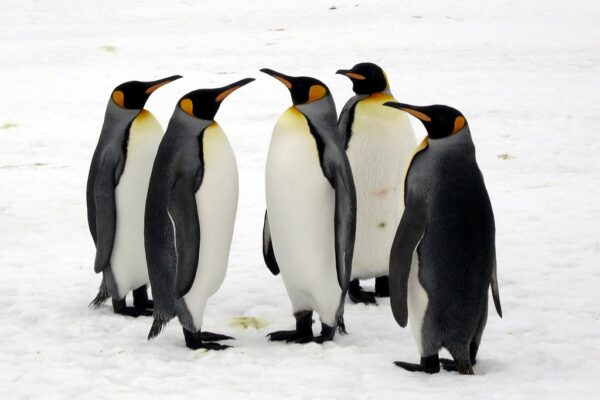


![17 Beautiful Blackbirds with Orange Beaks [Pictures + IDs]](https://birdsology.com/wp-content/uploads/2022/09/27-600x400.jpg)